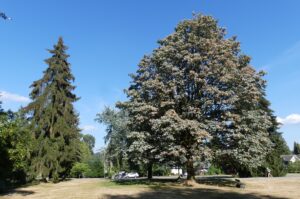The Hidden Life of TREES, Part 2
When I first wrote about Peter Wohlleben’s book, The Hidden Life of TREES (2015), I couldn’t help feeling so proud of the research which UBC’s Dr. Suzanne Simard wrote about in Finding the Mother Tree: Discovering the Wisdom of the Forest (2021). I feel so fortunate to be living in the best neighbourhood of the North Shore, with Grand Boulevard and its twelve blocks of ‘parkland’, including so many gorgeous, humongous trees!
 Left: Spruce Right: Big Leaf Maple
Left: Spruce Right: Big Leaf Maple
Now, I want to tell you a bit more about Peter’s research. He wasn’t always a researcher. He began his career in forestry in a tiny village in Germany called Hümmel, looking at hundreds of trees daily, “to assess their suitability for the lumber mill and their market value”. (p.xiii) That’s the way everyone looked at trees—useless, unless their wood could fetch a good price. In the late 1990s, Peter began to organize survival training and log-cabin tours for tourists, and then showing people an ancient forest preserve, where trees were left undisturbed. He began to observe things about trees and forests that he had never taken the time to notice before.
In the forest, it’s not ‘survival of the fittest plant’ but rather ‘A chain is only as strong as its weakest link.’ The roots of a tree are its most important part. A tree develops a partnership with a fungus, which “penetrates and envelopes the tree’s roots” (p.51) and enables the tree’s roots to grow and connect with other trees’ fungal partners. This helps to create a network for trees to exchange vital nutrients. For example, plants that cooperate with fungal partners have twice as much life-giving nitrogen and phosphorus as plants without fungal partners. In return for food from their partner tree, a fungus produces plant hormones that help the tree’s cell growth. It filters out heavy metals and protects the tree from intruders.
In the underground, fungi operate like fiber-optic Internet cables. A single fungus can send chemical signals and electrical impulses over many square miles. In fact, Peter tells us about a Honey fungus in Switzerland that covers almost 120 acres and is about 1000 years old. It’s the biggest fungus in Europe, but Oregon has the Largest Organism on Earth, a fungus estimated to be 2,400 years old, over 2000 acres large and weighing 660 tons. (p.50) (…as of 2015. Follow the links for updated information.)
František Baluška, et al, at the University of Bonn, researched Communication in Plants, in 2007, and wrote about ‘brain-like structures’ at tree root tips:
When a root feels its way forward in the ground, it is aware of stimuli. …If the root encounters toxic substances, impenetrable stones or saturated soil, it analyzes the situation and transmits the necessary adjustments to the growing tip. The root tip changes direction as a result of this communication and steers the growing root around the critical areas. (p.83)
Next time you walk on Grand Boulevard, imagine the fungus that is probably connecting all those great big trees underground.
Fiona
